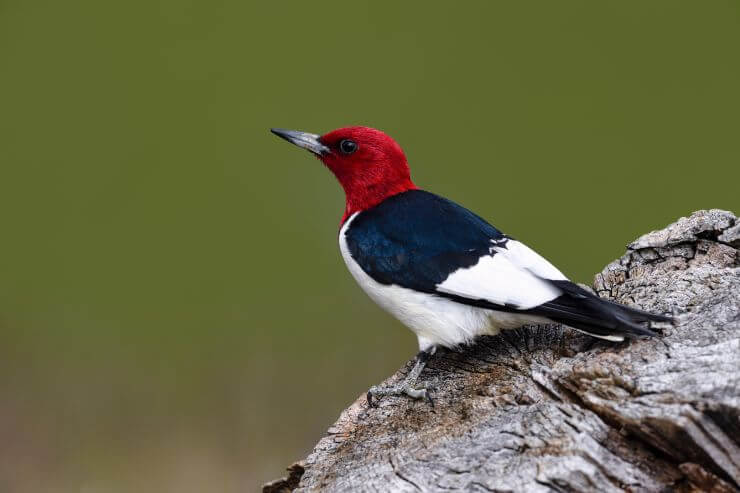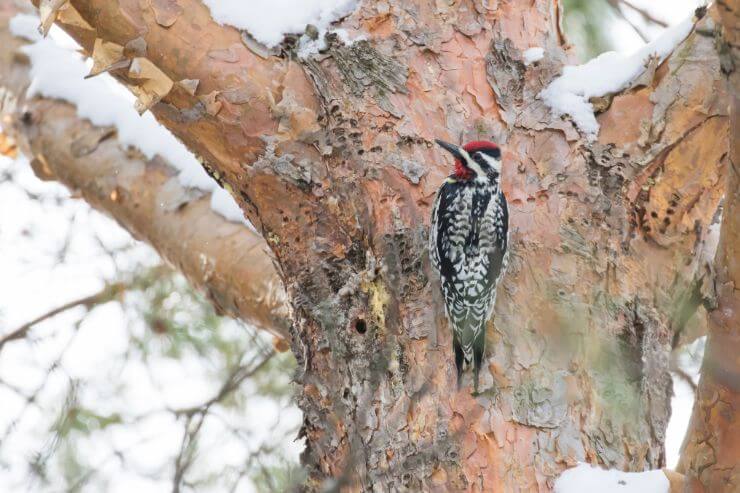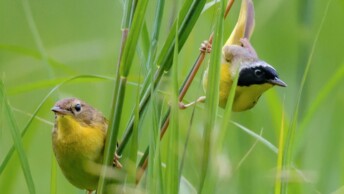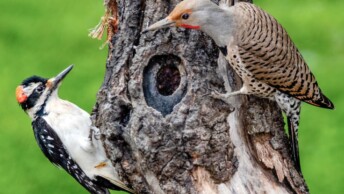Woodpeckers are a familiar sight in West Virginia, delighting residents with their bold markings and lively behavior. Known for their distinct drumming and impressive climbing skills, these birds spend much of their time searching for insects and building cozy nesting spots in tree cavities. Their strong bills and specialized skulls allow them to peck at wood without harm, turning any woodland area into their personal workshop.
West Virginia is home to several woodpecker species, each with unique features and habits. By keeping an eye out for flashes of red and black, you may catch a glimpse of these energetic birds in your own backyard or on a forest trail. In this article, I’ll tell you all about the different woodpecker varieties, discuss how they thrive in the state’s diverse habitats, and offer tips to help you enjoy these remarkable birds.
Whether you’re a lifelong birder or starting out, there’s much to discover.
1. Red-Headed Woodpecker
- Scientific name: Melanerpes erythrocephalus
- Life span: 8 – 10 years
- Size: 19 to 25 cm (7.5 to 9.8 in)
- Weight: 56 to 97 g (2.0 to 3.4 oz)
- Wingspan: 35 to 43 cm (14 to 17 in)
- Status: Least Concern
- State status: Breeding and rare
- Migratory behaviour: Partially migratory; often moves south, returning in late spring.
The Red-headed Woodpecker ranges across much of eastern and central North America, favouring open woodlands, orchards, and wooded swamps. Its most striking feature is the deep red coloring that covers the entire head and neck, creating a vivid contrast against its white underparts and black wings.
Large white wing patches become obvious in flight, flashing dramatically between trees. This species is known for bold attitudes and strong territorial behavior, making it memorable wherever it appears.

They favor open woodlands with standing dead trees or decaying limbs, carving cavities that offer easy entry and exit routes. Both partners work together, clearing loose debris until the interior feels sufficiently spacious. Their brilliant crimson heads occasionally peek out as they monitor the surroundings.
Once eggs appear, cooperative incubation ensures consistent warmth. Nearby snags are often defended as additional storage or future nest sites, and this strategy increases the likelihood of raising a successful brood.
Red-headed Woodpeckers actively hunt flying insects, snapping them in midair with precision. They also forage along trunks for hidden beetles or grubs, occasionally caching acorns in crevices for leaner times. This adaptable approach helps them switch between protein sources and plant material as needed.
They visit feeders stocked with nuts or suet, bringing flashes of vivid color to backyards. By adjusting their feeding habits, they cope with seasonal changes and remain resilient throughout shifting environments.
Red-headed Woodpeckers once faced declines due to large-scale clearing of oak savannas and standing dead trees. As these habitats disappeared, nesting and food supplies diminished, prompting alarm among bird enthusiasts.
Today, reforestation and farmland reversion help restore partial ranges. Wildlife agencies recommend leaving snags intact, ensuring suitable cavities remain. Historic records detail varying local abundance, with some regions experiencing rebounds.
2. Pileated Woodpecker
- Scientific name: Dryocopus pileatus
- Life span: 6-10 years
- Size: 16-19 inches
- Weight: 10-12 oz
- Wingspan: 26-30 inches
- Status: Least concern
- State status: Breeding and common
- Migratory behaviour: Year-round resident; seldom leaves West Virginia.
The Pileated Woodpecker resides in forested regions across much of southern Canada and the eastern United States. This crow-sized species is instantly recognizable by its bold black body, broad wings, and prominent crest of red feathers.
White stripes run along the sides of its neck, highlighting its striking appearance. It often announces its presence with loud, resonant calls that echo through the woods. Confident and strong, this bird favours mature forests and heavily wooded surroundings.

They typically select tall, decaying trees in extensive forests for their nest sites, chiseling deep cavities with distinct rectangular openings. Both mates share the excavation process, removing large wood chips to create ample space for eggs. Once inside, the chamber provides safety from predation and harsh weather.
Pileated Woodpeckers often reuse favored territories but excavate new cavities each year. Territorial calls echo through the woods, alerting neighbours that these imposing woodpeckers have claimed their domain.
They famously feast on carpenter ants found in decaying wood, using their powerful bills to remove large sections of bark. This exposes hidden tunnels where insects dwell, providing a plentiful food source. They also consume termites, beetle larvae, and occasional fruits or nuts.
Their vigorous drumming can uncover deeper layers of wood, revealing an array of tasty morsels. When necessary, they adapt by visiting backyard feeding stations, showcasing impressive resourcefulness even in more urbanized regions.
Historically, overharvesting of mature forests reduced nest opportunities, lowering numbers. As reforestation advanced, populations rebounded, where large tracts of woodland regrew. Modern conservation emphasizes preserving older stands, ensuring decaying trees remain whenever safe.
Educating landowners about these needs helps maintain healthy breeding sites across West Virginia. Field surveys document steady or increasing presence in suitable habitats. Research also explores how fragmentation affects movement, guiding efforts to protect corridors essential for Pileated Woodpecker survival and dispersal.
3. Yellow-Bellied Sapsucker
- Scientific name: Sphyrapicus varius
- Life span: 5-8 years
- Size: 8-10 inches
- Weight: 2.5 oz
- Wingspan: 14-16 inches
- Status: Least concern
- State status: Breeding and rare
- Migratory behaviour: Departs for southern regions each fall, returns in spring.
The Yellow-bellied Sapsucker can be found across eastern North America, extending into parts of Canada during breeding season. It is recognized by its patterned black-and-white face, along with a red forehead and crown that give it a distinctive look.
Some individuals display a yellow wash on the underparts, lending the species its name. Preferring deciduous and mixed forests, it often drills rows of small holes in tree bark. Birders prize its appearance and distinctive tapping.

They often select living trees with softer wood, such as birch or aspen, drilling a cavity for their brood. Both partners help remove wood chips, forming a secure chamber where eggs will rest on the natural substrate.
These sites can be reused in subsequent years, although new cavities may be created if conditions shift. Territorial tapping warns others to keep their distance. Once the eggs hatch, attentive parents diligently guard against predators in nearby forests.
They are best known for creating rows of sap wells, which they revisit for sugary liquid. Insects drawn to the sap provide added protein, making these wells rewarding. They also gather small arthropods from bark, occasionally sampling fruit when available.
This technique of drilling shallow holes helps them tap a steady flow, sustaining them through varying seasons. Their specialized tongue enables them to lap sap efficiently, an adaptation that distinguishes Yellow-bellied Sapsuckers from other woodpeckers.
Historically, sapsuckers faced threats when forests were logged and dead trees removed, limiting nesting sites. Over time, second-growth stands provided new opportunities, allowing populations to expand into previously cleared areas.
Conservation measures prioritize retaining snags and encouraging diverse forest composition. Bird monitoring data reveals fluctuating numbers, tied to migration routes and breeding habitat availability. Public outreach now highlights the ecological value of these cavity creators.
4. Downy Woodpecker
- Scientific name: Picoides pubescens
- Life span: 2-5 years
- Size: 6-7 inches
- Weight: 1 oz
- Wingspan: 13 inches
- Status: Least concern
- State status: Breeding and common
- Migratory behaviour: Year-round resident; doesn’t typically leave West Virginia.
The Downy Woodpecker can be found across much of North America, including forests, parks, and suburban areas. It sports a stubby bill and distinctive black-and-white striped pattern along its back, with a subtle white patch in the center.
Males show a small red patch on the back of the head, adding a splash of color to their otherwise monochrome feathers. Frequently seen clinging to trunks, this bird’s adaptable nature allows it to thrive in habitats.

They pick soft or partially decayed trees for nest cavities, often located in small trunks or sturdy branches. Both male and female chisel diligently, removing flakes of wood to create a sheltered chamber lined with wood chips. This cozy space supports their eggs and newly hatched chicks. Their choice of nesting site ensures protection from weather and predators. They may fiercely defend this territory, chasing away intruders to maintain a safe environment for their family.
They favor insects like beetles and larvae, pecking methodically to uncover meals hidden under bark. Occasionally, they supplement with seeds, fruit, or nectar, sampling whatever is readily available across diverse habitats.
Suet at backyard feeders can be a particular draw, sustaining them through colder months. Their compact bill is well suited for prying into small crevices, ensuring they rarely miss a tasty morsel. With resourceful foraging habits, they manage to thrive even in challenging conditions.
Historical records indicate stable numbers, as these adaptable woodpeckers inhabit forests, parks, and suburban neighborhood. They benefited from the presence of dead or dying trees, which remain crucial for nesting. Conservation groups emphasize responsible forestry practices, protecting woodlots and leaving standing snags intact.
Educating landowners about the importance of preserving habitat has helped support populations throughout West Virginia. Citizen science initiatives, such as bird counts, continue providing valuable data to guide long-term planning efforts statewide.
5. Hairy Woodpecker
- Scientific name: Picoides villosus
- Life span: 5-10 years
- Size: 7-10 inches
- Weight: 1.5 oz
- Wingspan: 16-20 inches
- Status: Least concern
- State status: Breeding and common
- Migratory behaviour: Year-round resident; rarely leaves West Virginia.
The Hairy Woodpecker inhabits a broad swath of North America, favouring mature woodlands, forest edges, and even urban settings. It has a longer bill compared to its smaller cousins and displays prominent black-and-white barring on its wings.
A striking white patch stretches down the center of its back, creating a bold pattern. Males exhibit a red patch on the back of the head. Confident and active, this species is frequently observed exploring trunks and branches.

They typically favor mature forests with standing snags or partially decaying trees, chiseling deep cavities for their eggs. Both partners collaborate, taking turns removing wood chips to fashion a snug interior lined with natural materials.
These nest sites are often placed higher above ground, providing additional safety from ground-dwelling predators. Once the eggs are laid, both adults share incubation duties, ensuring constant warmth. Territorial displays discourage rivals, helping guarantee a secure environment for the brood.
These woodpeckers diligently search tree trunks for insects, probing for hidden beetle larvae and other small creatures. With a stronger, longer bill than some relatives, they can extract prey from deeper recesses. They also consume nuts, berries, and seeds when insects are scarce. Suet feeders occasionally draw them closer to human activity, especially during winter. Their persistent tapping reveals burrowing pests, providing a beneficial service to forests and woodlots.
Over time, forest clearing threatened local populations by reducing nesting and foraging sites. However, as reforestation efforts progressed, Hairy Woodpeckers regained ground in many areas. Conservation strategies today focus on maintaining mature stands and preserving standing dead trees.
Historical accounts depict this species as resilient, often bouncing back wherever habitats improve. Public awareness campaigns encourage bird-friendly forestry practices, highlighting the importance of biodiversity. Monitoring programs track regional numbers, guiding decisions that support healthy woodpecker communities.
6. Northern Flicker
- Scientific name: Colaptes auratus
- Life span: 5-8 years
- Size: 8-10 inches
- Weight: 2.5 oz
- Wingspan: 14-16 inches
- Status: Least concern
- State status: Breeding and common
- Migratory behaviour: Some migrate south; others stay year-round in West Virginia.
The Northern Flicker spans a large portion of North America, inhabiting woodlands, open fields, and suburban areas. Unlike many woodpeckers, it frequently forages on the ground, showing distinctly brownish plumage with spotted underparts.
A black crescent on the chest sets it apart, and males display a colorful mustache marking. Its wings flash vivid yellow or red when in flight, depending on region. Known for loud calls, this bird brings a lively presence wherever it appears.

Northern Flickers frequently choose dead or decaying trees, although they sometimes adapt to fence posts or utility poles. Both partners excavate a chamber, discarding wood chips to form a soft floor.
Males and females share incubation once eggs are laid, rotating to keep them warm. Unlike some woodpecker species, flickers defend a broader territory, ensuring adequate resources for their growing family. Their chosen cavity provides safety from predators and shelter from West Virginia’s changing weather.
Though many woodpeckers scale trunks, flickers are often found on the ground, probing for ants and beetles. They use their curved bill to reach underground insects, flicking aside debris with swift motions. In wooded or partially open areas, they occasionally sample fruits or seeds. This adaptable feeding style enables them to exploit diverse habitats across the state. During chilly months, bird feeders may tempt them, creating a welcome opportunity for birdwatchers to appreciate their presence.
Logging and agricultural expansion reduced suitable nesting sites for Northern Flickers, although their adaptability helped them persist. Over time, partial regrowth of forests and urban landscaping created new opportunities for foraging. Conservationists encourage landowners to leave dead trees standing when safe, as these provide ideal cavity locations.
Historical accounts suggest fluctuations in numbers, linked to habitat availability. Research tracks migration patterns, informs habitat management, and promotes best practices for sustaining flicker populations across West Virginia.
7. Red-Bellied Woodpecker
- Scientific name: Melanerpes carolinus
- Life span: Up to 15 years
- Size: 9 to 10.6 inches (23 to 27 cm)
- Weight: 2 to 3.2 ounces (57 to 91 grams)
- Wingspan: 13 to 16.5 inches (33 to 42 cm)
- Status: Least concern
- State status: Breeding and common
- Migratory behaviour: Year-round resident; primarily stays within West Virginia.
The Red-bellied Woodpecker is widespread across the eastern United States, inhabiting woodlots, suburbs, and mixed forests. Its back and wings showcase a bold zebra-like pattern, while the head features a brilliant red crown extending from forehead to nape.
Though its belly patch can be faint, it lends the species its distinctive name. Often heard before seen, it produces calls that resonate through treetops. Adaptive and inquisitive, this bird easily occupies a range of wooded environments.

They carve their nest chambers in snags or decaying limbs, typically choosing a secluded spot away from high traffic. Both partners diligently remove debris, leaving a bed of wood chips at the bottom for cushioning eggs.
Their defensive calls alert neighbours that this territory is occupied. Once eggs are laid, both adults alternate incubation, maintaining a presence. By selecting elevated cavities, they reduce predation risks, ensuring their hatchlings can safely develop within West Virginia’s forests.
They frequently probe under bark for insects, pausing to hammer open hidden compartments where beetles and larvae lurk. Seeds and nuts supplement their meals, especially as seasons shift. When fruit ripens, they snatch bites from orchard trees or wild vines. Bird feeders stocked with suet and sunflower seeds sometimes entice them closer to homes. With a strong, curved bill, they can glean nourishment from various sources, demonstrating adaptability in both rural woodlands and suburban settings.
Historically, land clearing reduced their woodlot habitats, decreasing potential nest trees. Gradually, reforestation and suburban growth allowed them to recover, finding new opportunities around yards and parks. Modern strategies emphasize preserving snags where feasible and promoting native trees in landscaping.
Citizen science projects track shifts in their distribution, revealing steady or expanding ranges. Observers note that backyard feeding stations further support local populations.
Where to look for Woodpeckers of West Virginia
Woodpeckers can be found all across West Virginia, from thick forests to neighborhood woodlots, if you know where to look. They thrive in areas with mature trees, often dead or decaying, since those provide nesting and feeding opportunities. To spot them, head out early in the morning or late in the afternoon, when bird activity tends to be highest. Bring binoculars, move quietly, and listen for the distinctive drumming sounds they produce on tree trunks. Once you hear the rapid knocking, scan the surrounding branches to find the source.
Some excellent places to see woodpeckers in West Virginia include Kanawha State Forest near Charleston, known for its extensive hiking trails and diverse tree stands; Dolly Sods Wilderness in the Monongahela National Forest, with mixed woodlands offering prime feeding grounds; Cacapon Resort State Park in the Eastern Panhandle, where well-maintained trails lead through scenic groves; and Cranberry Wilderness, renowned for its peaceful, old-growth forest habitat.
Remember to respect wildlife by keeping a safe distance and avoiding sudden movements. With patience and a bit of luck, you’ll be treated to an up-close look at these fascinating birds while enjoying West Virginia’s natural beauty. Take time to savour every sighting and appreciate nature.
Conclusion
The woodpeckers of West Virginia present a remarkable array of species and behaviors, from the small Downy to the impressive Pileated, each contributing to the vibrancy of the region’s forests. Observers are enthralled by their drumming and intricate foraging techniques, witnessing a delicate balance between wildlife and habitat.
Encouraging responsible land stewardship and supporting conservation initiatives ensures these avian wonders persist, delighting future generations with their distinctive presence in West Virginia for all.



